Foundations of Medieval Indian Literature: 600 CE to 1700 CE

Medieval Indian literature begins from the 7th century when Alwars and Nayanmars, a group of devotional poets appeared in South India. These devotional poets developed a literature completely different from classical literature in Sanskrit and Tamil.
We can divide medieval age in Indian literature in two major phases:
- Early Medieval Indian Literature that was produced between 7th to 14th century
- Late Medieval Indian Literature that was produced between 14th to 18th century: This is the period in which literary giants such as Kabir, Guru Nanak, Tulsidas, Sankaradeva, Sarala Das, Ezhuthachan, Potana, Chandidas and Narasimha Mehta wrote.
Before we explore middle age in Indian literature, we must keep in mind that India is a vast and diverse country, where multiple languages and dialects are spoken, and varied literatures are produced. Hence, there are multitude of linguistic, religious, political, cultural, and philosophical factors that have shaped the literatures of the period co-existing throughout the country.
Despite a perpetual power struggle throughout the northern and southern regions of the country, Medieval Indian Literature remained more or less unaffected. There was no direct relationship between literary innovations and political changes. Indian literature during the middle ages was more directly impacted by patronage, linguistic, and religious scenarios. The literature produced during the 7th - 14th century can be distinctly categorized as:
- Literature produced in royal courts. Works belonging to the medieval period were written for the elite. Therefore, they were written in Sanskrit. The literature produced in royal courts was mostly recited and read. Medieval Indian literature in Sanskrit was conditioned and controlled by royal patrons.
- Literature produced under the patronage of religious groups, temples, mathas, and monasteries. These works were written in languages usually other than Sanskrit. This literature was mostly religious and was meant to be sung to the masses. It was accompanied by musical instruments and dance performances. Literature produced by Śaiva and Vaishnava saints reflected their religious thoughts, while Jain and Buddist monks used literature as an effective instrument to propagate their respective religious ideas.
Political Scenario

There was no singular, stable political power in the country. The Gupta Empire had ended by the middle of the 6th century. One of the most prominent kings in the first half of the 7th century was King Harshavardhana who ruled from 606 CE to 647 CE. He was a playwright and a patron of poetry. After his death, many new dynasties ruled North India for short periods of time. Some of the more distinct dynasties of North India were the Palas of Bihar and Bengal, the Rashtrakutas of the Deccan, and the Gujara-Pratiharas of Malwa and Rajasthan. In South India too, there was no stability. There was a constant conflict among three dynasties-- the Chalukyas of Badami, the Pallavas of Kanchi, and the Pandyas of Madurai.
Linguistic Scenario
There were significant societal and linguistic changes in India around the 6th century that affected literature of the time. Linguistically, the medieval age of Indian literature lies in the second and third stages of the Middle Indo-Aryan period. Throughout medieval Indian literature, there existed a tension, a dilemma among the writers, to either choose Sanskrit, the language of the elite and educated, or to write in the language of the masses. For example, the Jains (who wrote in Prakrit) and Buddhists (who wrote in Pali) did not completely abandon Sanskrit, despite writing in the languages of the masses. During this period, there also existed tension between Sanskrit, which was supported by the kings of Pallava and Chola dynasties, and Tamil that had continued to gain popularity through the Bhakti movement, initiated by the Saivas and the Vaishnavas. While for the Saivas, Sanskrit and Tamil enjoyed equal importance, there was a split within the Vaishnavas into thenkalai and vadakalai. Thenkalai was the southern school of learning that supported Tamil, while Vadakalai was the northern school of learning that supported Sanskrit. Although many bhashas attempted to challenge Sanskrit’s lingual supremacy, it persisted throughout medieval Indian literature.
The Apabhramsa period (700 CE - 1000 CE)
The final stage of the Middle Indo-Aryan period is also known as the Apabhramsa period. Apabhramsa is the name of the final stages of the Prakrit languages that were the dominant languages of the Middle Indo-Aryan period, and had originated from Sanskrit. The most important languages of this period were Tamil, Sanskrit, Prakrit, Apabhramsa, and Pali.
Conventionally, the term Apabhramsa indicated inferior, sub-standard or corrupt speech. While Patanjali (the grammarian of 2nd century BC) considered Apabhramsa a corrupt speech, it was considered as the dialect of Abhiras (cow herds) by the scholar poet Dandin, who raised it to a literary status. Finally, scholars like Anandavardhana and Rajashekhara recognised it as a literary language. Sauraseni Apabhramsa was developed from the Sauraseni Prakrit and it was this language in which literatures were produced.
The Decline of Pali
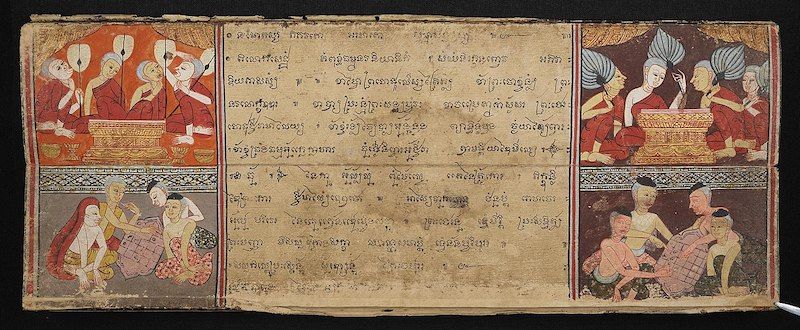
During the medieval period of Indian literature, the status of Pali, the dominant language of Buddhist literature began to decline. The last great scholar who had written in Pali was Budhhaghosha, a Buddhist scholar in the 5th-6th century. The two significant works written in Pali are:
- Padya Chudamani by Buddhaghosha (not the same as above)- a life story of Buddha in ten cantos. It may have been composed in the 12th century
- Jinacharita by Medhankara- a 470 stanzas long poem about the life of Buddha, composed in the 13th century.
After the decline of Pali by the end of the 12th century, it was Sanskrit that became the literary language of Buddhism.
Status of Sanskrit
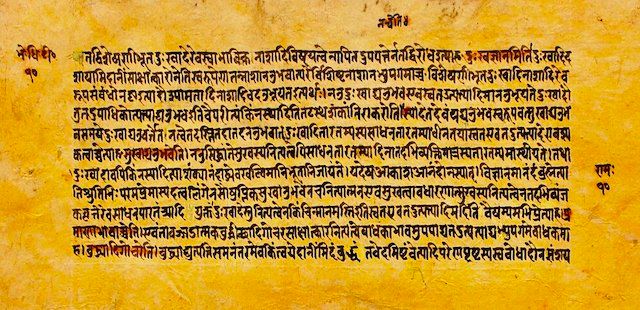
Sanskrit was the language of the educated and elite, spoken exclusively by Brahmins. It enjoyed prestige and reverence throughout the country. Unlike Dravidian languages such as Tamil, and more recent Kannada and Telugu, Sanskrit transcended regional boundaries and was a literary language throughout India.Prakrit and Apabhramsa too were prevalent in larger regions than Tamil. Even Tamil Nadu had many educational centers for Sanskrit. Although, male dominant, there were many women who composed poetry in Sanskrit. There is also evidence that the audience for literature produced in Sanskrit was not exclusively male. Despite being a significant and prestigious language, Sanskrit was not spoken by the masses. All the Puranas, Vedas, Upnishads were written in Sanskrit.
Status of Tamil
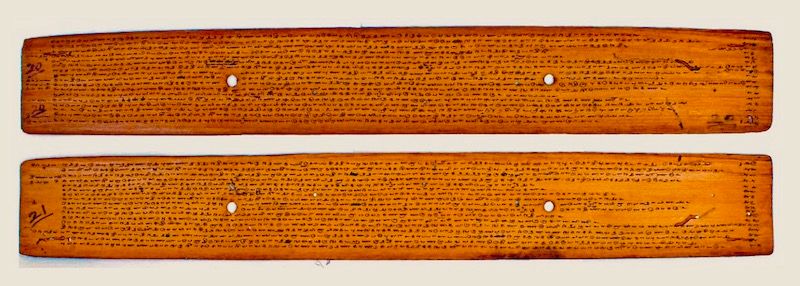
Tamil is the oldest language in India and was as powerful, popular and revered as Sanskrit. During the middle ages, Tamil changed significantly from the ancient Sangam Tamil. Nevertheless, the language has an uninterrupted history and since it underwent several significant changes throughout time, it has become both an ancient and a modern language at the same time. The language also enjoyed a larger readership or audience as compared to Sanskrit. The great and popular Bhakti literature was developed in Tamil.
Cultural Scenario of Medieval Indian Literature
Loss of Folk Literature
Most of the Medieval Indian literature was either religious, or was produced for the elite royals. However, there also existed works that were for the entertainment of the common people. These works were neither religious, nor required any deep literary knowledge to enjoy them. Unfortunately, such works did not survive due to the lack of their preservation.
Modes of Transmission
During the middle ages, producing literary texts was difficult due to limited resources, illiteracy and high cost. Therefore, almost all medieval Indian literature was transmitted orally. This was done by professional story-tellers, singers, and performers, who used to memorize texts. The practice of silent reading did not exist at that time. Only religious and academic institutions, and the rich could afford to have libraries.
Places of Performance
As discussed above, medieval Indian literature was either produced at the court intended for the king, elite and the educated, or for religious or entertainment purposes intended for the masses. Literature for the masses was often performed or recited in the temples, while literature for the Kings was performed in the royal courts. The audience for court poetry was extremely selective and small. On the other hand, literature performed and recited in the temples was meant for larger audiences, irrespective of their social or economical status. The poetry and literature produced in the royal court was different from that produced for the masses.
Status of Authors
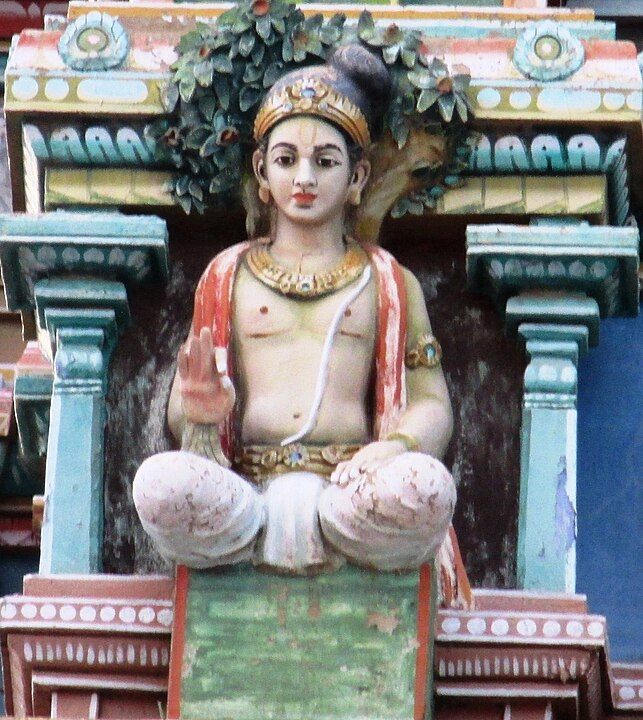
The poets and authors who wrote for the royal courts were extremely educated Brahmins, belonging to reputed families. For example, Sudraka and Harsha were kings, Vishakhadatta was a prince, Bhavabhuti came from a family where Taittiiriyaveda was studied, and Bana was a Brahmin of Vatsyayanas. Dandin, who might be the author of the well known Kavyadarsha was also a renowned Brahmin scholar. Kumaradasa and Magha too had affluent ties.
The poets from the South belonged to both upper and lower class. Saint poets such as Appar and Nammalwar came from Vellala, while Tirruppan Alwar was a highly educated poet who belonged to a lower caste. Despite not belonging to the upper caste and not being rich, these saint poets were extremely revered by the masses. The Jain and Buddhist writers (or poets) were mostly monks and lived in monasteries. Female writers and poets were extremely few during this age. Most significant women writers of the era are Mahadeviyakka (Akka Mahadevi) who was among the earliest poets of Kannada literature, Karaikkal Ammaiyar (foremost figures of Tamil literature), and Andal or Kothai (the hindu poet-saint of South India).
Audience of Medieval Indian Literature.
Besides royal patrons, the audience of Medieval Indian Literature also impacted the kind of works that were produced. As discussed before, most of the Sanskrit poetry was recited to a very exclusive and elite audience. All Sanskrit literature during the 7th and 8th century referred to specific gosthis or group in the various fields of learning, art and literature. Gosthis were periodically assembled either at a public hall, at the houses of courtesans, or were hosted by any one of the nagarkars (aristocrats). The group or the gosthi that was exclusively devoted to academic discussions on scriptures was called Sastragosthi. These discussions were conducted in the homes of learned ascetics. Gosthi that was focused on creative and critical writing was called Vidagdha gosthi. Members of this group were expected to be extremely creative and imaginative. Discussions held within Vidagdha gosthi led to the production of works like Kavyadarsha by Dandin. Kathagosthi was the group that was interested in imaginary, legendary, or biographical stories narrated in ornate kavya style. Works like Avantisundari Katha by Dandin were meant for Kathagosthi.
There also existed Sanskrit poetry that was recited to an audience that was not always attentive or receptive. To entertain and gain appreciation from such listeners, the poets prioritized immediate appeal rather than evoking emotions that could be appreciated later in peace and tranquility. Such poetry was full of captivating imagery, alliteration, similes and resembled lingual acrobatics. There was also a general shift in the nature of Sanskrit poetry. It had become decorative, pedantic and erotic. The unabashed eroticism in Sanskrit poetry was a conscious attempt by the poet to entertain the aristocrats.
Impact of Ancient literature on the Medieval Age
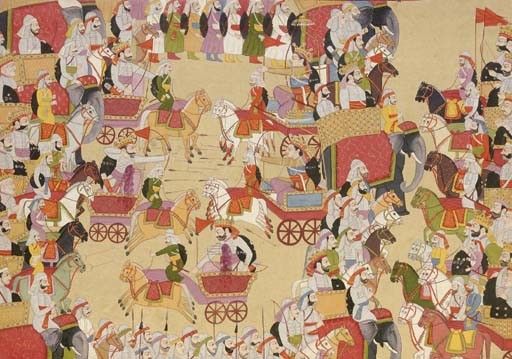
The medieval Indian literature inherited a vast religious and philosophically rich ancient literature. Even though ancient literature could not be preserved and memorized in its entirety, much of it continued to influence both the poets as well as the common masses.
The Vedas and the Upnishads were exclusively guarded by the Brahmins and were inaccessible to the general public. Nevertheless, the ideas and philosophy contained in them eventually penetrated among the masses and significantly influenced their culture, thought and literature. Among the most significant ancient epics that continued their influence throughout the medieval ages were the Ramayana and the Mahabharata. Both the epics underwent inevitable changes in the middle ages. However, they still retained their complex morality, imagination and preserved their antiquity.
Medieval Indian literature in Tamil was also significantly impacted by ancient works. The akam and puram poetry of the Sangam literature, the epic Silappadikaram by Jain author Ilango Adigal, Manimekalai by the Buddhist poet Maduraikkuavankar Cattanor and Tirukkural regulated the creativity of the poets and the writers of Medieval Indian literature.
One of the most significant and noticeable changes of the Medieval Indian Literature in Tamil is its transition from being secular to becoming thoroughly religious. Bhakti literature, the highlight of medieval Indian literature, did not sever its ties entirely from secular ancient literature. In classical Tamil literature, God was the model for the protagonist and many poets elevated the hero to a God-like pedestal. Eventually, the hero in ancient literary works began to be identified as God or divine. The devout saint poets of Bhakti literature protested against praising a king or a protagonist instead of God. It is interesting to note that the Alwars and Nayanmars never glorified temples erected by Kings in their literary works in spite of traveling and visiting them throughout the country.
Impact of Religion on Medieval Indian literature

Medieval literature was deeply connected with religion and philosophy of that time. In Medieval India, God was the center of life, and almost all creative activities were dedicated to divine power. It was believed that all creative power was a gift of the almighty. Thus, the ultimate underlying motive of the majority of Medieval Indian literature was to glorify God. This belief unified all artistic and creative activities of medieval India.
Several religious sects emerged during the middle ages. At the same time there was a decline of Buddhism and Jainism but a rise of Brahmanical religion. As a result, there was also a rise in the construction of temples and idol worship along with elaborate rituals. Brahmanism developed the concept of trimurti or the three forms of the Supreme power -- Brahma, Vishnu and Maheshwara.
There also existed a perpetual struggle among sects, particularly between Saivism (followers of lord Shiva) and Vaishnavism (worshippers of lord Vishnu). Another prominent sect was Shaktism. All the sects were sustained by Puranas that were written in Sanskrit. In addition to the Puranas, Saivism was theologically based on twenty-eight agamas. These agamas were composed at the time when Saivism had established itself in the South. Additionally, during the 13th and 14th century, Saiva-Siddhanta were composed that further renewed and enhanced Tamil Saivism. The Nayanmars were a group of 63 saints who represented Saivism and significantly influenced the Bhakti movement.
The Vaishnavism sect had its roots linked to the Bhakti philosophy, but was still a new sect. Its literary and emotional roots were in the poetry of the Alwars. Bhagavata Purana was the pivotal literature for the Vaisnavas.
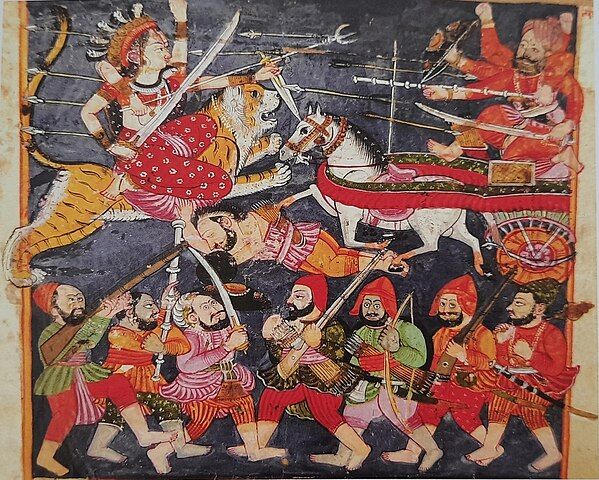
The people belonging to the cult of Shakti worshiped her as the superior to Shiva. The sect had many Tantric texts and nigamas. The chaters 81 to 93 of the Markandeya Purana included a complete work titled Devi-Mahatmya or Chandi. It included several verses to celebrate the glory of Durga or Chandi and the supremacy of Shakti as the Goddess of the universe.
Besides these prominent sects, there were some that were confined to smaller groups such as Siddhars. Despite being extremely radical, they continued to compose poetry that depicted a different religious life and literature of medieval India.
The Puranas
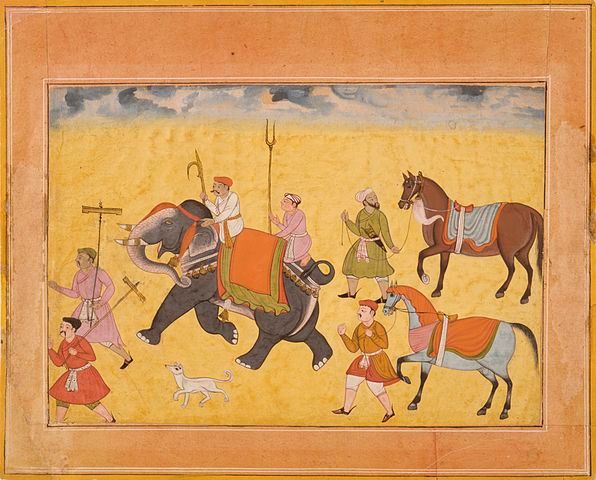
Puranas were literary texts that contained stories of god and genealogies of the sages.They significantly impacted the mentality of the people. As discussed above, the puranas were extremely crucial in preserving and promoting the ideas of various sects. They constituted a very important part of medieval Indian literature. There were eighteen puranas defending and promoting one of the three sects of Vaishnava, Saiva, and Shakta, and were grouped accordingly. The puranas that promoted the sect of Vaishnava were the Bhagavata Purana, Matsya, Kurma, Varaha, Vamana, Padma, and Brahma-Vaivarta. It is interesting to note that the epic poem Raghuvamsa by Kalidasa was based on the story of Rama as told in the Padma Purana. Puranas that worshiped Shiva as the supreme deity were Skanda, the Siva, the Linga, and the Bhavishya Purana. The Markandeya Purana was a text of the Shakta sect.
The puranas were extremely popular during the medieval age and gave rise to another kind of literature called the Upa-puranas (secondary purana) that were also eighteen in number. The upa-puranas were the foundations of Hinduism and were the source of various myths and religious as well as literary activities of medieval Hindu society. Puranas were intimately governed by sectarian interests and each sect had its puranas and upa-puranas. They held epic and encyclopedic significance in medieval Indian literature. Even though none of the puranas shared all the characteristics, there were some of the common features such as:
- Sarga or Creation
- Pratisarga or re-creation
- Vamsha or the genealogy of Gods and rishis
- Manvantara or cosmic cycles presided by Manu, the ancestor of mankind
- Vamshanu Charita or accounts of royal dynasties
The epics Mahabharata and Ramayana, along with the puranas contributed to the perception of a unified India despite the perpetual existence of political disunity. The literary works created an India that was sacred and blessed with holy mountains such as the Himalayas, Vindhyachal; rivers like Ganga, Yamuna, Narmada, Godavari, Sarayu, Gomati, and Sindhu; forests like Dandakaranya and Pushkar Aranya; and lakes such as Manasa-Sarovara and Pushkara. These created a sacred geography.
The geography of medieval Indian literature is regionally accurate but it also includes mythical elements of sacred India as written in the epics and the puranas. This is a very significant feature of the literary works that were produced in the medieval age. Even though there are supernatural and miraculous elements in hagiographies and other medieval literary works, they did not make literature completely unrealistic. Despite the prevalence of myths and miracles there is a persistent and strong sense of realism where real life is portrayed in vivid details. Eventually, the realistic element began to get stronger around the 9th and 10th century. It was during this time that anthologies of short verses written in Sanskrit were written and compiled, and Buddhist Sahajiya poetry was composed. These literary works were refreshingly close to real life and its people.
As discussed above, the majority of medieval Indian literature was either produced for the elite or for religious motives. Such kinds of texts were not much focused on being realistic. Thus, during and after the 8th century, there was a persistent tension between the elements of realism in everyday life and the philosophical perception of the world being illusory and transient.
Philosophies and works of Sankara and Ramanuja
The ideological foundations of medieval Indian literature were established by two seminal philosophers- Sankara and Ramanuja.
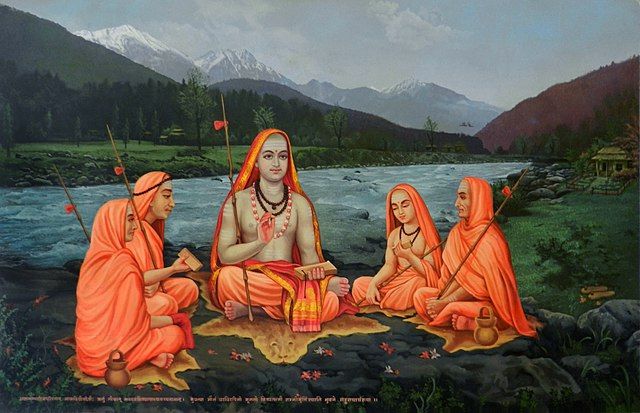
Sankara was born in the eighth century and was from Kalādi or modern day Kerala. He renounced his domestic life at a very young age and traveled the sub-continent in the pursuit of liberation. Sankara questioned the nature of God, the world and the relation between God and man and Brahma and Jiva. Sankara was taught by Govinda who was the pupil of Gaudapāda, the composer of Gauḍapādakārikās in the Māṇḍūkya Upaniṣad. Sankara wrote the earliest commentaries on the Brahmasūtras, Bhagavadgītā and Upanishads (Īṣā, Kena, Kaṭha, Praṣna, Muṇḍaka, Māṇḍūkya, Aitareya, Taittirīya, Chāndogya, and Bṛhadāraṇyaka). He also composed Upadeśasāhasrī or ‘A Thousand Teachings’. Sankara was a towering and significant philosopher and a teacher of the medieval age who established his philosophy of nondual brahman, and systemized Advaita Vedānta. He also introduced the concept of maya. The philosophical teachings of Sankara had a significant impact on the common Indian thought and were prevalent in medieval Indian literature. It was Sankara who made Vedanta the rural philosophy of India. Sankara was such a significant philosopher and teacher, that he was often the subject of many medieval Indian literary works like Shankara Digvijaya and Shankara Vijaya. The key points related to Sankara’s philosophy are:
- Non Dualism or Advaita Vedanta: Sankara taught that there is only singular reality, called Brahman. All the apparent diversity in the world is just an illusion or maya. According to Sankara, the individual self is one with the Brahman. This is the core principle of Sankara’s philosophy.
- Maya or Illusion: The apparent diversity in the world is maya or an illusion. It is this illusion that makes people believe that they are separate from the world.
- Brahman: According to Sankara, Brahman is the ultimate reality that transcends all limitations, space, time, and casualty. The ultimate goal of human life and the key to liberation from the cycle of birth and death is to realize one’s unity with Brahman.
- Jiva and Atman: According to Sankara, there is no difference between Jiva, the individual’s soul and Atman, the true self. It is because of maya or illusion that they appear to be different.
- Three levels of reality: Sankara proposed three levels of reality. Paramarthika or absolute reality, Vyavaharika or transactional reality, and Pratibhasika or illusory reality.
Sankara developed his philosophy of non duality through the knowledge gained from the Vedas and the Upnishads.
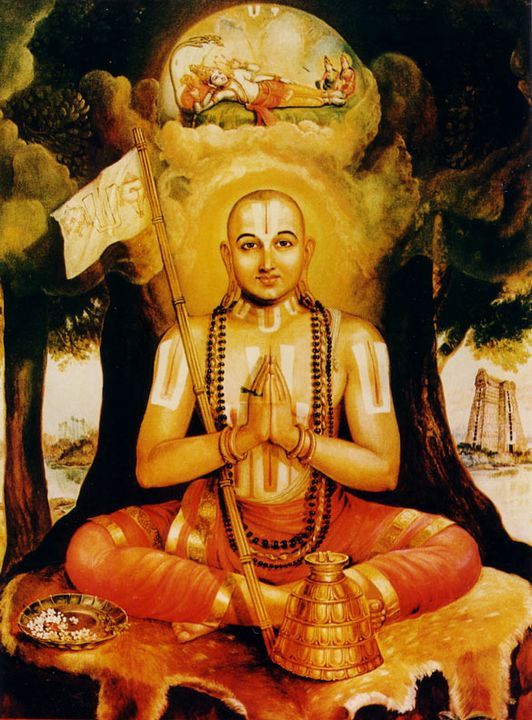
Ramanuja was born in 11th-12th century near modern Chennai. He studied under his guru Yadava Prakasha and enjoyed tremendous power as a religious leader. Immensely influenced by the Alwars, Ramanuja had a tolerant and liberal outlook towards religion. Just like Sankara, he traveled throughout the country, met scholars, and established mathas. He was devoutly followed by many powerful Kings, and rich men, and converted many Buddhists and Jains into Vaishnavism.
Ramanuja proposed the philosophy of Vishishtadvaita Vedanta or Qualified Non-Dualism that emphasized the supremacy of bhakti. Although he agreed with Sankara that Brahman is the ultimate reality, he challenged him and believed that Atman or an individual’s soul and the material world are real manifestations of Brahman rather than being an illusion or maya. In contrast to Sankara, Ramanuja asserted that Brahman is not without attributes. It is in fact, the very source of all attributes like infinite knowledge, power, and happiness. For him, our souls have a distinct identity and are not in complete union with the Brahman, just interconnected with it. Just like Sankara, Ramanuja too philosophized three levels of reality, and emphasized on Vedas and Pancharatra Agamas as the ultimate source of spiritual knowledge.
Ramanuja also wrote commentaries on Brahma Sutra called Shri Bhasya which became one of the most significant works of medieval Indian literature. He also commented on the Divya-Prabandham, the anthology of Tamil songs composed by the Alwars, and on Sahasra-giti composed by Nammalwar (one of the twelve Alwar saints).
The philosophical strain in medieval Indian literature did not end with the works of Ramanujan, Sankara and their followers. A vast body of philosophical literary works were written for many following centuries.
Significant characteristics of Medieval Indian Literature
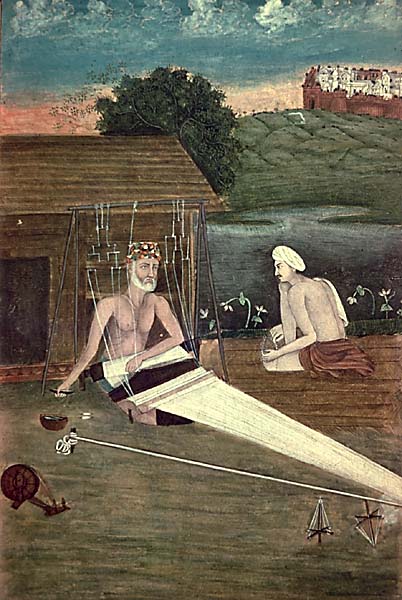
- One of the most distinct features of Medieval Indian literature is the existence of diverse schools of thought and philosophical debates throughout the country- such as Venkatanatha or Meghanadari of the Ramanujan school, Nimbarka school, Madhava school, Vallabha school, or the followers of Chaitanya, etc. These philosophical debates did not always directly impact the literature but significantly impacted the intellectual thought of the poets and the writers of the middle ages.
- The medieval Indian literature is extremely diverse and includes poetry and texts from various schools of thoughts and religions that did not always exist in harmony.
- On one hand the medieval age is characterized by the prevalent tension between dualists and non-dualists or between Saivas and Vaishnavas, while on the other hand, there also exists a search for religious harmony that became more prominent with the advent of the Muslim power in India. This tradition of religious harmony was most powerfully expressed in the later half of medieval Indian literature through the works of Kabir, Guru Nanak and Dadu.
- Parallel to the great syncretic tradition were smaller, obscure sects like the followers of Baba Lal and the Pran Nathis. Baba Lal was a Kshatriya born in Malva whose tenets included a fusion of both Vedanta and Sufi doctrines. Similarly, the Pran Nathis were the followers of Pran Nath, a Kshatriya who was well versed in both Vedic and Islamic learning.
- Even though the majority of Medieval Indian literature is religious, it does not include only hymns, prayers and theological works. There also exist literary works about mundane worldly realities, human pain and desires.
- There is continuous and organic experimentation in meter and forms of narration and representation throughout the medieval period. For instance, the ancient epics of the Ramayana and the Mahabharata are not preserved in antiquity, but are renewed in the spirit of medieval India.
References
Dalal, Neil. “Śaṅkara.” Stanford Encyclopedia of Philosophy, Metaphysics Research Lab, Stanford University, 2021, plato.stanford.edu/entries/shankara/.
Sisir Kumar Das, and Sahitya Akademi. A History of Indian Literature, 500-1399 : From Courtly to the Popular. New Delhi, Sahitya Akademi, 2005
